List of Neapolitan monarchs
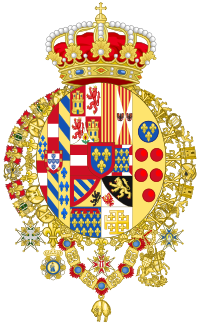
The following is a list of rulers of the Kingdom of Naples, from its first separation from the Kingdom of Sicily to its merger with the same into the Kingdom of the Two Sicilies.
Kingdom of Naples (1282–1501)
House of Anjou
In 1382, the Kingdom of Naples was inherited by Charles of Durazzo, King of Hungary, great grandson of King Charles II of Naples. After this, the House of Anjou of Naples was renamed House of Anjou-Durazzo, when Charles married his first cousin Margaret of Durazzo, member of a prominent Neapolitan noble family.
| Portrait | Coat of Arms | Name | Reign | Claim to the throne | Title | |
|---|---|---|---|---|---|---|
 | 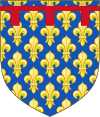 | Charles I (Carlo I) | 30 March 1282 | 7 January 1285 | • Conquered the Kingdom of Sicily from Manfred as a part of the war between the Hohenstaufen dynasty & the Papacy • Following the Sicilian Vespers in 1282, the island of Sicily was lost to Peter III of Aragon | King of Sicily, Naples and Albania (Re di Sicilia, Napoli e Albania) |
 | 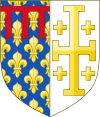 | Charles II, the Lame (Carlo II, lo Zoppo) | 7 January 1285 | 5 May 1309 | • Son of Charles I | King of Naples (Re di Napoli) |
.jpg/440px-Robert_of_Naples_(head).jpg) |  | Robert I, the Wise (Roberto I, il Saggio) | 5 May 1309 | 20 January 1343 | • Son of Charles II | King of Naples (Re di Napoli) |
.jpg/440px-Joan_I_of_Naples_(head).jpg) |  | Joanna I (Giovanna I) | 20 January 1343 | 12 May 1382 | • Granddaughter of Robert I | Queen of Naples (Regina di Napoli) |
 |  | Louis I (Luigi I) | August 1348 | 26 May 1362 | • Husband of Joanna I • Grandson of Charles II; member of the House of Anjou-Taranto | Jure uxoris King of Naples (Re di Napoli) |
| After Joanna's death without legitimate issue, the heirs were her nieces, only one (Margaret) of whom left issue (with Charles, a member of the Durazzo branch of the House of Anjou). The next ones in line were the Durazzo branch itself (the Taranto branch, of which Louis I was part, had been extinguished), whose prominent figure, Charles, was Joanna's enemy. | ||||||
.jpg/440px-Charles_III_of_Naples_(head).jpg) |  | Charles III, the Short (Carlo III, il Breve) | 12 May 1382 | 24 February 1386 | • Great-grandson of Charles II and second cousin of Joanna I of Naples • Member of the House of Anjou-Durazzo | King of Naples (Re di Napoli) |
.jpg/440px-Ladislas_of_Naples_(head).jpg) |  | Ladislaus I, the Magnanimous (Ladislao I, il Magnanimo) | 24 February 1386 | Early 1390 | • Son of Charles III | King of Naples (Re di Napoli) |
House of Valois-Anjou (disputed)
Joanna of Naples had refused to name her enemy Charles of Durazzo as heir to the Neapolitan throne despite him ending up succeeding her anyway. If Charles' line was ignored, the subsequent heirs would be the descendants of Margaret, Countess of Anjou, a daughter of Charles II of Naples; the line pointed to the kings of France of the House of Valois. Joanna chose this line, though she named as heir, her second cousin once removed, Louis of Valois-Anjou, the second son of King John II of France, in order to avoid a personal union with France.
As Charles III had already seized the Neapolitan throne, initially the House of Valois-Anjou only had an empty claim. One of their members, Louis II, succeeded in ruling Naples for a time.
Time as claimant instead of actual rule will be shown in italic.
| Portrait | Coat of Arms | Name | Reign | Relationship with Predecessor(s) | Title | |
|---|---|---|---|---|---|---|
 |  | Louis I of Anjou (Luigi I) | 1382 | 1384 | • Adopted son and heir of Joanna I • Great-great-grandson of Charles II through female line • Could not establish himself in Naples before his death | King of Naples (Re di Napoli) |
 |  | Louis II (Luigi II) | 1384 1389 | 1417 1399 | • Son of Louis I (adopted son of Joanna I) • Crowned in 1389 • Actually ruled in Naples only from 1390 until 1399 | King of Naples (Re di Napoli) |
 |  | Louis III of Anjou (Luigi III) | 1417 | 1434 | • Son of Louis II • He was recognised as Joanna II's heir in 1423. | King of Naples (Re di Napoli) |
House of Anjou (restored)
| Portrait | Coat of Arms | Name | Reign | Relationship with Predecessor(s) | Title | |
|---|---|---|---|---|---|---|
.jpg/440px-Ladislas_of_Naples_(head).jpg) |  | Ladislaus I, the Magnanimous (Ladislao I, il Magnanimo) | Late 1399 | 6 August 1414 | • Son of Charles III | King of Naples (Re di Napoli) |
 |  | Joanna II (Giovanna II) | 6 August 1414 | 2 February 1435 | • Daughter of Charles III | Queen of Naples (Regina di Napoli) |
House of Valois-Anjou (restored)
Joanna II recognised Louis III of Anjou as heir in 1423, however he died in 1434 before succeeding to the throne. His brother René of Anjou succeeded to the claim and became king upon Joanna's death in 1435.
| Portrait | Coat of Arms | Name | Reign | Relationship with Predecessor(s) | Title | |
|---|---|---|---|---|---|---|
.jpg/440px-Le_musée_d'Histoire_de_Marseille_(14202563122).jpg) |  | René I, the Good (Renato I, il Buono) | 2 February 1435 | 2 June 1442 | • Son of Louis II | King of Naples (Re di Napoli) |
House of Trastámara
Before Louis of Anjou, Queen Joanna II's adopted heir had been Alfonso V of Aragon. His father, Ferdinand I of Aragon had inherited both Aragon & Sicily from his maternal uncle Martin I of Aragon. Martin, in turn had claimed the throne of Sicily following the extinction of the Sicillian branch of the House of Barcelona, thereby bringing Sicily under the Aragonese crown. Alfonso refused to be disinherited and conquered Naples from René of Anjou in 1442. Although both Sicily & Naples were once again under the rule of the single monarch since the Sicillian Vespers, Alfonso passed the Aragonese throne (including Sicily) to his brother John, while Naples went to his illegitimate son Ferdinand.
| Portrait | Coat of Arms | Name | Reign | Relationship with Predecessor(s) | Title | |
|---|---|---|---|---|---|---|
 |  | Alfonso I, the Magnanimous (Alfonso I, il Magnanimo) | 2 June 1442 | 27 June 1458 | • Adopted son of Joanna II; conquered | King of Aragon, Sicily and Naples (Re di Aragona, Sicilia e Napoli) |
 |  | Ferdinand I (Ferdinando I) | 27 June 1458 | 25 January 1494 | • Illegitimate son of Alfonso I | King of Naples (Re di Napoli) |
 |  | Alfonso II (Alfonso II) | 25 January 1494 | 23 January 1495 | • Son of Ferdinand I | King of Naples (Re di Napoli) |
 |  | Ferdinand II (Ferdinando II) | 23 January 1495 | 7 September 1496 | • Son of Alfonso II | King of Naples (Re di Napoli) |
 |  | Frederick I (Federico I) | 7 September 1496 | 1 August 1501 | • Son of Ferdinand I | King of Naples (Re di Napoli) |
Union with France (1501–1504)
Upon his death in 1480, René of Anjou transferred his claim to his nephew, Charles IV, Duke of Anjou. Charles died in 1481 and willed his claim to Louis XI of France. His son Charles VIII attempted to take Naples by force, but failed and died childless in 1498.
Charles VIII was succeeded by his 2nd cousin once removed Louis XII. Louis had no claim to the Neapolitan throne, but as successor to Charles VIII in France he nevertheless wanted to succeed him in Naples as well.
Naples was conquered in 1501 and became part of a personal union with the Kingdom of France. The local government was ruled by a French viceroy.
House of Valois-Orléans
| Portrait | Coat of Arms | Name | Reign | Relationship with Predecessor(s) | Title | |
|---|---|---|---|---|---|---|
 |  | Louis XII of France (Luigi XII) | 2 August 1501 | 31 January 1504 | • Succeeded to Charles VIII on the French throne; conquered Naples | |
Union with Spain (1504–1647)
Ferdinand II of Aragon conquered Naples from the French in the Treaty of Granada. Naples, alongside Sicily entered in a personal union with the Kingdom of Aragon, which lasted for over 2 centuries. Over time, the Crown of Aragon and the Crown of Castile merged to form the Monarchy of Spain, known colloquially as the "Kingdom of Spain", though the constituent crowns (Castile, Aragon, Sicily, Naples) retained their own institutions, and were ruled officially as separate states in personal union rather than as a unified state. The local government was ruled by a Spanish viceroy. The royal houses were:
- House of Trastámara (1504–1516)
- House of Habsburg (1516–1647)
House of Trastámara
| Portrait | Coat of Arms | Name | Reign | Relationship with Predecessor(s) | Title | |
|---|---|---|---|---|---|---|
 | 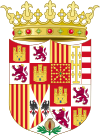 | Ferdinand III (Ferdinando III) | 31 January 1504 | 23 January 1516 | • Conquered Naples from Louis XII | |
 |  | Joanna III (Giovanna III) | 23 January 1516 | 12 April 1555 | • Daughter of Ferdinand III | |
Joanna III was kept confined under alleged insanity during her whole reign.
House of Habsburg
| Portrait | Coat of Arms | Name | Reign | Relationship with Predecessor(s) | Title | |
|---|---|---|---|---|---|---|
 |  | Charles IV (Carlo IV) | 14 March 1516 | 25 July 1554 | • Son of Joanna III | |
 | 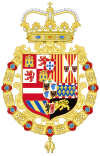 | Philip I | 25 July 1554 | 13 September 1598 | • Son of Charles IV | |
 |  | Philip II | 13 September 1598 | 31 March 1621 | • Son of Philip I | |
 |  | Philip III | 31 March 1621 | 1647 | • Son of Philip II | |
Neapolitan Republic (1647–1648)
House of Guise
Officially a Republic, Naples was governed for a short time by the Duke of Guise, under the title of "Doge of Naples".
| Portrait | Coat of Arms | Name | Reign | Relationship with Predecessor(s) | Title | |
|---|---|---|---|---|---|---|
 |  | Henry of Guise (Enrico di Guisa) | 22 October 1647 | 5 April 1648 | • Claimed a lineage with the House of Valois-Anjou | Doge of Naples (Doge di Napoli) |
Union with Spain (1648–1713)
Naples returned to its former status; in personal union with the Crown of Aragon and the Spanish monarchy.
House of Habsburg
| Portrait | Coat of Arms | Name | Reign | Relationship with Predecessor(s) | Title | |
|---|---|---|---|---|---|---|
 |  | Philip III | 1648 | 17 September 1665 | • Son of Philip II | |
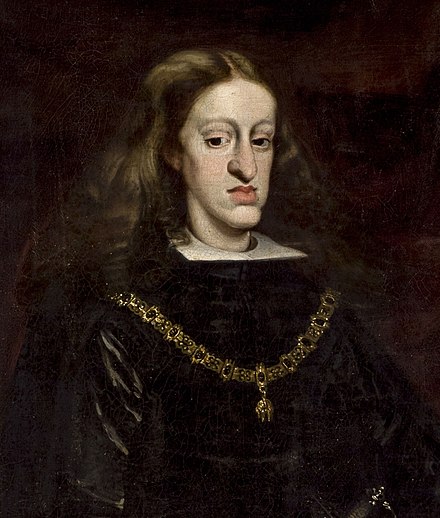 |  | Charles V | 17 September 1665 | 1 November 1700 | • Son of Philip III | |
House of Bourbon
| Portrait | Coat of Arms | Name | Reign | Relationship with Predecessor(s) | Title | |
|---|---|---|---|---|---|---|
 |  | Philip IV | 1 November 1700 | 11 April 1713 | • Great-nephew of Charles V | |
Kingdom of Naples (1713–1799)
Under the terms of the Peace of Utrecht the crown of Naples passed to the Austrian Habsburgs.
House of Habsburg
| Portrait | Coat of Arms | Name | Reign | Relationship with Predecessor(s) | Title | |
|---|---|---|---|---|---|---|
,_Holy_Roman_Emperor.jpg/440px-Charles_VI_(1685-1740),_Holy_Roman_Emperor.jpg) |  | Charles VI | 11 April 1713 | 1734/1735 | • Great-grandson of Philip I | |
House of Bourbon
In 1734 Spanish troops conquered the Kingdom of Naples, which was surrendered to Charles of Bourbon under the Treaty of Vienna (1738).
| Portrait | Coat of Arms | Name | Reign | Relationship with Predecessor(s) | Title | |
|---|---|---|---|---|---|---|
 | 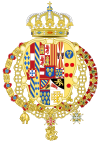 | Charles VII (Carlo VII) | 2 June 1734 | 6 October 1759 | • Son of Philip IV; confirmed King with a treaty (1738). Abdicated, 1759 to assume the throne of Spain. | King of Spain, Naples and Sicily (Re di Spagna, Napoli e Sicilia) |
 |  | Ferdinand IV (Ferdinando IV) | 6 October 1759 | 23 January 1799 | • Son of Charles VII | King of Naples and Sicily (Re di Napoli e Sicilia) |
Parthenopean Republic (1799)
Dictators
| Nº | Portrait | Name (Birth–Death) | Term of Office | Political Party | Ref. | |
|---|---|---|---|---|---|---|
| 1 |  | Jean Étienne Championnet (1762–1800) | 21 January 1799 | 24 February 1799 | Military | |
| Championnet was appointed to defend the Roman Republic, but despite the French Directory's directives, he also conquered Naples and created the Parthenopean Republic. After a short dictatorship, he was deposed and imprisoned by France itself. | ||||||
| 2 |  | Jacques MacDonald (1765–1840) | 24 February 1799 | 3 June 1799 | Military | [1] |
| After Championnet's deposition, MacDonald ruled Naples for some months, before moving his forces in Northern Italy. Naples was then reconquered by the Bourbons' loyalists. | ||||||
Kingdom of Naples (1799–1816)
| Portrait | Coat of Arms | Name | Reign | Relationship with Predecessor(s) | Title | |
|---|---|---|---|---|---|---|
 |  | Ferdinand IV (Ferdinando IV) | 13 June 1799 | 30 March 1806 | • Son of Charles VII | King of Naples and Sicily (Re di Napoli e Sicilia) |
House of Bonaparte
| Portrait | Coat of Arms | Name | Reign | Relationship with Predecessor(s) | Title | |
|---|---|---|---|---|---|---|
.jpg/440px-Joseph_Bonaparte_(by_Wicar).jpg) |  | Joseph I (Giuseppe I) | 30 March 1806 | 8 July 1808 | • Appointed by Napoleon Bonaparte, abdicated 1808 to assume the throne of Spain. | King of Naples (Re di Napoli) |
House of Murat
| Portrait | Coat of Arms | Name | Reign | Relationship with Predecessor(s) | Title | |
|---|---|---|---|---|---|---|
_(A).jpg/440px-Joachim_Murat_(1767-1815)_(A).jpg) |  | Joachim-Napoleon (Gioacchino Napoleone) | 1 August 1808 | 22 May 1815 | • Brother-in-law of Joseph I | King of Naples (Re di Napoli) |
House of Bourbon-Two Sicilies
| Portrait | Coat of Arms | Name | Reign | Relationship with Predecessor(s) | Title | |
|---|---|---|---|---|---|---|
 |  | Ferdinand IV (Ferdinando IV) | 22 May 1815 | 8 December 1816 | • Son of Charles VII | King of Naples and Sicily (Re di Napoli e Sicilia) |
Naples was merged with Sicily to form Kingdom of Two Sicilies.
See also
- List of monarchs of the Kingdom of the Two Sicilies
- List of consorts of Naples
- List of viceroys of Naples
- List of monarchs of Sicily
- Kings of Naples family tree
References
- ^ Acton, Harold (1957). The Bourbons of Naples (1731–1825) (2009 ed.). London: Faber and Faber. ISBN 9780571249015.